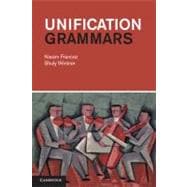
Note: Supplemental materials are not guaranteed with Rental or Used book purchases.
Purchase Benefits
What is included with this book?
| Preface | p. ix |
| Acknowledgments | p. xii |
| Introduction | p. 1 |
| Syntax: the structure of natural languages | p. 3 |
| Linguistic formalisms | p. 4 |
| A gradual description of language fragments | p. 6 |
| Formal languages | p. 12 |
| Context-free grammars | p. 14 |
| CFGs and natural languages | p. 22 |
| Mildly context-sensitive languages | p. 29 |
| Motivating an extended formalism | p. 30 |
| Feature structures | p. 34 |
| Motivation | p. 35 |
| Feature graphs | p. 37 |
| Feature structures | p. 52 |
| Abstract feature structures | p. 54 |
| Attribute-value matrices | p. 64 |
| The correspondence between feature graphs and AVMs | p. 74 |
| Feature structures in a broader context | p. 83 |
| Unification | p. 85 |
| Feature structure unification | p. 85 |
| Feature-graph unification | p. 86 |
| Feature structure unification revisited | p. 93 |
| Unification as a computational process | p. 94 |
| AFS unification | p. 99 |
| Generalization | p. 108 |
| Unification grammars | p. 115 |
| Motivation | p. 116 |
| Multirooted feature graphs | p. 118 |
| Abstract multirooted structures | p. 125 |
| Multi-AVMs | p. 130 |
| Unification revisited | p. 137 |
| Rules and grammars | p. 146 |
| Derivations | p. 151 |
| Derivation trees | p. 157 |
| Linguistic applications | p. 165 |
| A basic grammar | p. 166 |
| Imposing agreement | p. 167 |
| Imposing case control | p. 172 |
| Imposing subcategorization constraints | p. 174 |
| Subcategorization lists | p. 178 |
| Long-distance dependencies | p. 185 |
| Relative clauses | p. 191 |
| Subject and object control | p. 197 |
| Constituent coordination | p. 201 |
| Unification grammars and linguistic generalizations | p. 208 |
| Unification-based linguistic formalisms | p. 209 |
| Computational aspects of unification grammars | p. 213 |
| Expressiveness of unification grammars | p. 214 |
| Unification grammars and Turing machines | p. 226 |
| Off-line parsability | p. 233 |
| Branching unification grammars | p. 239 |
| Polynomially parsable unification grammars | p. 244 |
| Unification grammars for natural languages | p. 251 |
| Parsing with unification grammars | p. 253 |
| Conclusion | p. 275 |
| List of symbols | p. 277 |
| Preliminary mathematical notions | p. 280 |
| Solutions to selected exercises | p. 284 |
| Bibliography | p. 299 |
| Index | p. 307 |
| Table of Contents provided by Ingram. All Rights Reserved. |
The New copy of this book will include any supplemental materials advertised. Please check the title of the book to determine if it should include any access cards, study guides, lab manuals, CDs, etc.
The Used, Rental and eBook copies of this book are not guaranteed to include any supplemental materials. Typically, only the book itself is included. This is true even if the title states it includes any access cards, study guides, lab manuals, CDs, etc.